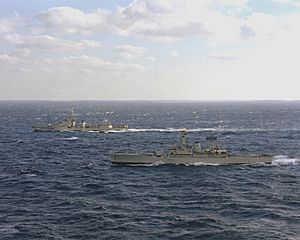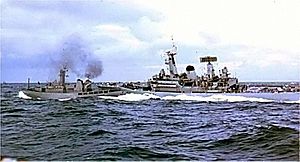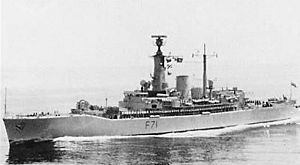HMS Scylla (F71) facts for kids

The British frigate Scylla and the French destroyer La Galissonniere underway during NATO exercises on 18 November 1978
|
|
Quick facts for kids History |
|
|---|---|
| Name | HMS Scylla |
| Builder | Devonport Royal Dockyard |
| Laid down | 17 May 1967 |
| Launched | 8 August 1968 |
| Commissioned | 12 February 1970 |
| Decommissioned | December 1993 |
| Fate | Sunk as an artificial reef on 27 March 2004 |
| General characteristics | |
| Class and type | Leander-class frigate |
| Displacement | 3,200 long tons (3,251 t) full load |
| Length | 113.4 m (372 ft) |
| Beam | 12.5 m (41 ft) |
| Draught | 5.8 m (19 ft) |
| Propulsion | 2 × Babcock & Wilcox boilers supplying steam to two sets of White-English Electric double-reduction geared turbines to two shafts |
| Speed | 28 knots (52 km/h) |
| Range | 4,600 nautical miles (8,500 km) at 15 knots (28 km/h) |
| Complement | 223 |
| Armament |
|
| Aircraft carried |
|
HMS Scylla (F71) was a Leander-class frigate, a type of warship, that served in the Royal Navy (RN). She was built at Devonport Royal Dockyard. Scylla started service in 1970 and was taken out of service in 1993. In 2004, she was purposely sunk to become an artificial reef, a special underwater home for sea life and a place for divers to explore.
Contents
Building and Service of HMS Scylla
In early 1966, the British Admiralty, which managed the Royal Navy, ordered Scylla. She was a "Broad-Beam" Leander-class frigate. Her construction at Devonport Dockyard cost millions of pounds.
Key Dates for HMS Scylla
Scylla began construction on 17 May 1967. She was officially launched into the water on 8 August 1968. The ship started active service on 14 February 1970. She was given the pennant number F71, which is like a unique ID for a warship.
HMS Scylla in the 1970s
On 22 January 1973, Scylla had a small accident with the Torpoint ferry. This happened while Scylla was on sea trials after some repairs. The ferry got a small hole in its front. Later, the ship's captain was disciplined for the incident.
In May 1973, Scylla was sent to help British fishing boats. This was during a disagreement with Iceland about fishing rights, known as the Second Cod War. Scylla patrolled the waters to stop Icelandic patrol boats from bothering British fishing vessels. On 1 June, an Icelandic patrol boat called Aegir bumped into Scylla. This was the first time such an incident happened during the fishing dispute.
The fishing disagreements with Iceland became worse in 1975. This led to the Third Cod War. From February 1976, Scylla continued to support British fishing trawlers. In May, Scylla escorted the royal yacht Britannia. This was when Queen Elizabeth II visited Finland.
Scylla also took part in the Spithead Fleet Review in 1977. This was a big parade of ships held to celebrate Queen Elizabeth II's Silver Jubilee. This marked 25 years since she became Queen.
HMS Scylla in the 1980s
In 1980, Scylla helped the island of Cayman Brac after it was hit by a strong hurricane. After this, Scylla went into a major update in 1980. This update added new equipment like advanced sonar, Exocet and Sea Wolf missile launchers, and a Westland Lynx helicopter. This update took four years and cost a lot of money. Because of this, Scylla was not available to serve during the Falklands War.
After her update, Scylla served as a guard ship for the West Indies. She also patrolled the Persian Gulf as part of the Armilla Patrol. In November 1986, she escorted Britannia again. This was during a visit by Prince Charles and Princess Diana to the Middle East.
In late December 1987, while on patrol, Scylla and the American ship USS Elrod helped two ships. These ships, the Korean Hyundai No 7 and the British Eastern Power, had been attacked. After the Korean ship was attacked, Scylla's crew used her Westland Lynx helicopter to rescue some of the crew members.
HMS Scylla in the 1990s
In 1990, Scylla had another update that lasted 10 months. By 1993, Scylla was the last ship of her class still in active service. Her final mission was to the South Atlantic that year. By this time, the ship was getting old and hard for engineers to keep running.
During this patrol, Scylla had steering problems. She accidentally bumped into the tanker RFA Gold Rover. Scylla only had minor damage, but Gold Rover needed repairs to her hull. Scylla was officially taken out of service in December 1993. In 1992, the city of Aberdeen gave Scylla and her crew the special honour of Freedom of the City of Aberdeen.
Sinking and Use as a Dive Site
On 27 March 2004, Scylla was purposely sunk off Whitsand Bay, Cornwall. She became the first artificial reef of its kind in Europe. The ship was placed on a sandy seabed about 24 meters (79 feet) deep. This spot is about 500 meters (1,640 feet) from another shipwreck, the Liberty ship James Eagan Layne, which has been a popular dive site for many years.
Scylla is now a popular spot for divers. However, there have been concerns about mud and silt from the nearby Tamar estuary spreading through the ship. This can make the water cloudy and reduce visibility for divers. Because of this, the National Marine Aquarium, which manages the site, has advised divers not to go inside the wreck. Instead, they suggest divers enjoy the outside of the ship.
Images for kids




